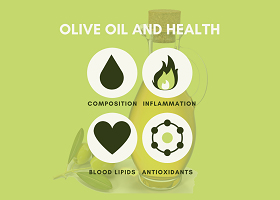Virgin Olive Oil and Health
A special issue of Nutrients (ISSN 2072-6643). This special issue belongs to the section "Lipids".
Deadline for manuscript submissions: closed (15 March 2022) | Viewed by 24550

Special Issue Editors
2. Centro de Investigación Biomédica en Red de Diabetes y Enfermedades Metabólicas Asociadas (CIBERDEM), Madrid, Spain
Interests: nutrients in diabetes etiopathogenesis; diabetes cell therapy; stem cell biology; functional foods
Special Issues, Collections and Topics in MDPI journals
Interests: nutrients; foods; diets; obesity; diabetes; metabolic syndrome; Alzheimer’s; extra virgin olive oil; pomace olive oil; macrophages; inflammation; lipoproteins
Special Issue Information
Dear Colleagues,
The benefits of the Mediterranean dietary pattern have been investigated in depth. Different Mediterranean diets have in common the use of olive oil, especially virgin olive oil (VOO), as the main dietary source of fats. Regular consumption of VOO has been associated with a lower incidence of non-communicable diseases. During the last decade, many epidemiological studies have correlated VOO intake with a healthy condition.
To date, meta-analysis studies have provided evidence indicating that olive oil consumption is beneficial for the prevention of cardiovascular diseases, several cancers, metabolic diseases, autoimmune diseases, and chronic-degenerative diseases.
The health benefits observed after VOO consumption are associated with its nutritional components, in particular monounsaturated fatty acids (MUFAs), but also minor components, including (poly)phenols, sterols, tocopherols, and terpenoids. The molecular and cellular mechanisms underlying the beneficial effects of VOO are mainly the antioxidant and anti-inflammatory properties. However, there are probably more mechanisms of action involved in VOO health effects.
Although great progress has been made in this research field, many issues have yet to be clarified, for example, the design of more interventional studies with VOO, the evaluation of the benefits of VOO as a sole food ingredient and not in the context of the Mediterranean diet, the amount of VOO intake that could considered beneficial, the identification of novel components with healthy properties, and the knowledge of new mechanisms of action among others.
The aim of this proposed Special Issue on “Virgin Olive Oil and Health” is to publish studies dealing with the role of VOO intake in human health and its mechanisms of actions. Reviews, meta-analyses, observational studies, intervention trials, experimental research, and mechanistic studies are all welcome.
Prof. Dr. Franz Martín
Dr. Javier S. Perona
Guest Editors
Manuscript Submission Information
Manuscripts should be submitted online at www.mdpi.com by registering and logging in to this website. Once you are registered, click here to go to the submission form. Manuscripts can be submitted until the deadline. All submissions that pass pre-check are peer-reviewed. Accepted papers will be published continuously in the journal (as soon as accepted) and will be listed together on the special issue website. Research articles, review articles as well as short communications are invited. For planned papers, a title and short abstract (about 100 words) can be sent to the Editorial Office for announcement on this website.
Submitted manuscripts should not have been published previously, nor be under consideration for publication elsewhere (except conference proceedings papers). All manuscripts are thoroughly refereed through a single-blind peer-review process. A guide for authors and other relevant information for submission of manuscripts is available on the Instructions for Authors page. Nutrients is an international peer-reviewed open access semimonthly journal published by MDPI.
Please visit the Instructions for Authors page before submitting a manuscript. The Article Processing Charge (APC) for publication in this open access journal is 2900 CHF (Swiss Francs). Submitted papers should be well formatted and use good English. Authors may use MDPI's English editing service prior to publication or during author revisions.
Keywords
- Virgin olive oil
- MUFAs
- Phenolic compounds
- Antioxidant effects
- Bioavailability
- Inflammation and anti-inflammatory effects
- Metabolic tissues
- Immune system
- Health properties of virgin olive oil
- Metabolic diseases
- Non-communicable diseases
- Aging
- Mediterranean diet
- Nutraceutical
- Meta-analysis and systematic reviews
- Minor components of olive oil







